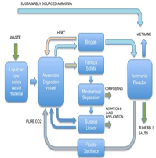
Pratik Desai
University of Sheffield, UK
Title: Solving the ammonia –carbon dioxide cycle – sustainable biomass utilization linked to a circular economy approach
Biography
Biography: Pratik Desai
Abstract
Microbubbles are bubbles sized between 1µm and 1000µm and offer tremendous advantages with respect to transport phenomena due to their high surface area to volume ratio [1]. Accelerated biogas production rate via periodic CO2 microbubble injection was demonstrated with over 100%-120% increase in the rate of biogas yield for an untreated wet food waste in an anaerobic digestion process [2]. Recently, Desai et al [3, 4] demonstrated a new unit operation –microbubble stripping – in order to separate ammonia from an ammonia rich wastewater stream 300 times faster than an industrial stripping column with a mass transfer coefficient 3000-15000 times faster than a stripper. [5,6]The removal rate was as high as nearly 100% from the wastewater. This process, when combined with the accelerated biogas production introduces the third novelty of generating precipitated salts of ammonium carbamate and ammonium carbonate by reacting the CO2 and NH3 in water which can be selectively tuned - another feature not observed in literature - and is performed at room temperature and pressure. This reaction is exothermic and using heat from the exothermicity of this process to conserve the heat for the anaerobic digester is part of process integration. The theory proposed for the increase in biogas production rate is that the CO2 bubbles provide a pH shock to the system. The biogas generated from the anaerobic digestion is then sweetened from the sustainably sourced ammonia from ammonia rich waste water (which reduces liabilities for liquids like centrate and leachate for waste management companies or increase capital efficiencies for digestate by reducing ammonia inhibition and increasing solids loading). This results in enhanced methane as a product from the digester, which coupled with a smaller CAPEX from the increased biogas yield rate and reduced OPEX due to the heat conservation reduces digester payback from 8y to 2y.

Recent Publication:
[1] Brittle, S.; Desai, P.; Ng, W. C.; Dunbar, A.; Howell, R.; TesaÅ™, V.; Zimmerman, W. B. Minimising microbubble size through oscillation frequency control. Chemical Engineering Research and Design 104, 357-
366.
[2] Al-mashhadani, M. K. H.; Wilkinson, S. J.; Zimmerman, W. B. Carbon dioxide rich microbubble acceleration of biogas production in anaerobic digestion. Chemical Engineering Science 2016, 156, 24-35.
[3] Desai,P., Turley,M., Robinson R., Zimmerman, W.B., Ammonia removal from wastewaters by hot microbubble injection in thin liquid layers, [ in prep, will be submitted in time for conference]
[4] Desai, P. D., Zimmerman, W.B. Hot microbubble injection in thin liquid layers for ammonia-water separations. In The 68th Annual Meeting of the American Physical Society - Division of Fluid Dynamics, Jose Gordillo, U. d. S., Ed.; APS: MIT, Boston, Massachusetts USA, 2015; Vol. 60.
[5] Kamaruddin, M. A.; Yusoff, M. S.; Aziz, H. A.; Hung, Y.-T. Sustainable treatment of landfill leachate. Applied Water Science 2014, 5 (2), 113-126.
[6] B, S.; Beebi. Sk, K. Bioremediation of Ammonia from Polluted Waste Waters- A Review. American Journal of Microbiological Research 2014, 2 (6), 201-210.

